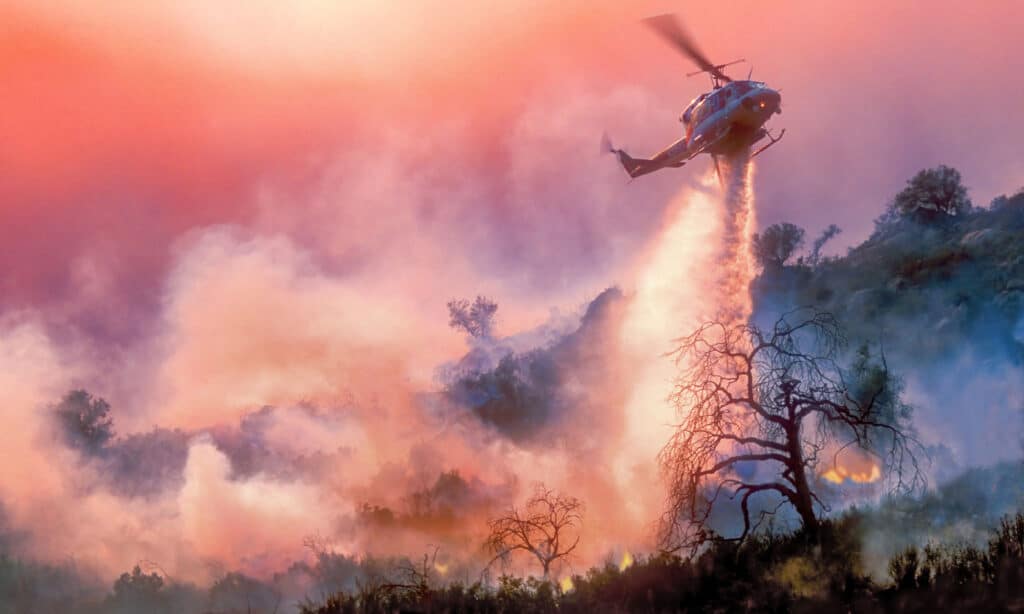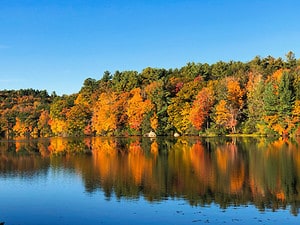Wildfires are increasingly common things, devasting millions of natural land, urban environments, and animal habitats. You might hear them called “forest fires,” “wildfires,” “brush fires,” and more.
In almost all cases, these fires are spread through areas of combustible vegetation. That means that these fires distribute themselves through plant matter, although they are caused by a number of things.
These fires aren’t always negative things, however. In fact, many ecosystems depend on wildfires to rejuvenate the land and keep the environment in balance. In other instances, human activity is the source of fires, either directly or through the process of man-made climate change.
The Definition of “Wildfire”
A wildfire is simply an unplanned burn that takes place in a natural area. The scope of the fire doesn’t have to be any larger than a field, a small area in the forest, or a grassland.
We imagine that “wildfires” have to be raging monstrosities that decimate huge areas of land. Instead, most are a lot smaller.
That doesn’t mean they’re not all dangerous, though. Under the right conditions, even the smallest wildfire could spread millions of acres.

Wildfires are devastating, but they can also serve to “reset” the environment, allowing new plants to grow and attracting insects and birds.
©Newtonian/Shutterstock.com
Healthy Wildfires
Fires, big and small, have been integral aspects of the earth’s ecosystem since terrestrial plants sprouted out of the earth. That means they’ve likely been around for more than 400 million years.
Interestingly, many of these fires are “ground fires.” That means they smolder underneath the ground, spreading quietly through roots and other matter. Later in a season, these ground fires typically make their way to the surface and hit the “refresh” button on the plant life above.
Many plants have co-evolved in the presence of wildfires and require regular fires to release seeds, germinate, access sunlight, and create space in the ecosystem.
These fires keep certain populations in check, even killing diseases that would devastate trees and plants if they were left unchecked. Many insects are attracted to forest fires as they eat primarily burned and fallen trees.
Those bugs are a welcome treat for the birds who come back to their home when the fire is over. Around that time, plants emerge from the healthier soil and feed all of the other herbivores returning to their homes.
So, in this natural process, fires are an essential thing.
The Fire-Stopping Paradox
It’s because wildfires are so beneficial and natural that they should be left undisturbed in some cases. Ecosystems have been utilizing this tool since long before dinosaurs emerged on earth.
As humans, we want to put out fires immediately. That has been the practice for a very long time. When there’s a fire, we put it out.
Unfortunately, putting out seasonal fires throws things out of balance and actually contributes to larger, more devastating fires in future years.
If you look at a chart of forest fire activity over a period of decades, you’ll see that the years following significant fires are pretty tame. In other words, one year is host to dozens of massive forest fires, and the next year or two typically have very few.
This happens because forest fires clear out much of the fuel (plant matter) that’s liable to combust. So, the fire sweeps through, cleans up all the debris, and the following year isn’t as likely to host a fire.
This back and forth across the years keeps the debris from getting too substantial. When there’s too much combustible plant matter available, though, forest fires have a bigger potential to spread beyond their natural borders.
So, as we put out seasonal fires, we’re setting ourselves up for huge wildfires that wouldn’t occur otherwise.

Humans tend to put out wildfires immediately, but this can lead to even more cataclysmic fires in the future.
©iStock.com/David Aughenbaugh
Why Have There Been More Wildfires Lately?
Every summer, wildfires start to rage through numerous areas of the United States. Massive as the fires may be, you might not hear about them as they’re drowned out by other events in the media. You might also live far enough from the majority of fires that you’re made aware of their existence.
In any case, at almost any time in the summer, there is likely a wildfire raging in or around places you’ve been or regions where your friends and loved ones live.
Scientists assert that the primary cause for the increase in wildfires is climate change. Temperatures are rising, for one. This contributes to moisture loss and an abundance of dry, combustible plant matter.
That’s the most obvious connection between climate change and wildfires. As most things go when it comes to ecosystems, however, the nexus of fire risks caused by climate change is a lot more complicated than most of us are aware of.
Here are just a few of the key climate-caused factors in the recent uptick in wildfires:
Shifts in Rainfall
Shifts in rainy season intervals and shorter rainy seasons caused by climate change also play a huge role. These are factors that lead to drought, which only intensifies the likelihood that wildfires will start and spread beyond their normal range.
The wildfire season has extended by roughly 1-2 months, on average, over the course of nearly 40 years.
In dry environments, things like lightning strikes are much more likely to start fires that spread rapidly. Arid land adjacent to deforested land provides an avenue for strong wind, unbroken by tree cover, to expand the borders of existing fires.
The Role of Trees
Deforestation is an issue that contributes to wildfires on multiple levels. For one, removing trees dramatically alters the health of forest ecosystems.
Trees play keystone roles in any environment they occupy. The loss of a tree, or a group of trees, will have a deep impact on the surrounding ecosystem. Not all of these factors will contribute to wildfires, but any shift in ecosystems could disrupt the balance that previously kept wildfires at bay.
Trees also provide a natural barrier to fires in some cases. A dense forest is much less conducive to fires than an acre of low-lying weeds.
This is significant because trees occupy a space that would otherwise be populated by combustible weeds and plants. So, when trees are gone, the forest floor becomes laden with plants that might as well be matchsticks.
Trees also cycle moisture through the ecosystem in a process called transpiration. This introduces water to the air, encourages heavier rainfall, and keeps fires at bay.
Finally, trees absorb a great deal of carbon dioxide and mitigate the concentration of greenhouse gasses in our atmosphere. Without these Co2 vacuums lining our forests, the earth will continue to heat up and dry out.
Human-Caused Fires
Human activity is another big contributor to the issue. In fact, one study suggests that humans have caused 84% of wildfires in the United States over the past few decades.
These researchers note that humans aren’t necessarily less responsible with their use of fire. It’s simply the fact that the environment is so much more vulnerable to fires in the face of climate change.
Some of the top human contributors to fires include people burning waste, arson, campfires, children playing with fire, and fireworks. According to one researcher, there were 7,762 fires started on the Fourth of July over the 20-year course of the study.
Fire-Stopping
We mentioned the practice of putting out fires earlier. Indiscriminately putting fires out sets forests and grasslands up for even larger fires in the following years.
The debris that would fuel the original fire becomes overgrown and feeds larger fires later on.
Frequency and Size
At the time this sentence was written (7/29/2022), there were 832 active wildfires in North America. Regions of France, Spain, Portugal, and Greece have been devastated by wildfires this year as well.
In addition to being more frequent, the wildfires are getting larger.
Over the past 40 years, the number of acres burned in wildfires has risen steadily. There were a little more than 5 million acres of U.S. land burned in wildfires in 1980. That was the highest number for the following 15 years.
Over the past 20 years, however, annual totals consistently reach more than 10 million U.S. acres burned in wildfires.
Where Do We Go From Here?
While it may seem like the stream of massive wildfires will never get better, there’s always hope for improvement. Improved fire maintenance practices and awareness about fire safety could greatly reduce the number of man-made fires.
Further, climate action and responsible stewardship of our earth are necessary to slow the frequency of dangerous wildfires. That’s a multi-faceted issue and cause for concern for us all.
Wildfire expert Stephen Pyne says that “the critical questions are cultural and political, not scientific.” That is to say, there are already clear scientific answers available that could rework the wildfire situation.
Namely, striking the perfect balance between wildfire prevention and controlled burns is possible. The primary challenges have to do with our cultures and political systems, however.
In large part, this is because so much of the issue deals with climate change, which is something that opposing groups have trouble reconciling. A real change to wildfires and climate change requires a revolutionary shift in the way we live our personal lives, shape communities, and interact with other cultures.
Until those changes take place, we can’t expect the wildfires to go anywhere.
Ready to Learn More?
- Here’s Exactly How Climate Change Impacts Animals
- News: Climate Change Setting Traps for Migratory Species
- Are There More Tigers in Texas Than in The Wild?
- 10 Rivers That Are Running Dry in 2022
The photo featured at the top of this post is © Dawn Wilson Photo/Shutterstock.com
Sources
- World Health Organization, Available here: https://www.who.int/health-topics/wildfires/#tab=tab_1
- MSN, Available here: https://www.msn.com/en-in/news/in-depth/explained-why-are-wildfires-intensifying-in-europe/ar-AAZFABU
- Fire Weather Avalanche, Available here: https://www.fireweatheravalanche.org/fire/
- We Forum, Available here: https://www.weforum.org/agenda/2021/08/wildfires-united-states-cause-science/
- Nature, Available here: https://www.nature.com/articles/ncomms8537
- Proceedings of the National Academy of Sciences, Available here: https://www.pnas.org/doi/full/10.1073/pnas.1607171113
- Insurance Information Institute, Available here: https://www.iii.org/fact-statistic/facts-statistics-wildfires
- Get Green Now, Available here: https://get-green-now.com/why-do-droughts-happen/
- Scientific American, Available here: https://www.scientificamerican.com/article/climate-change-may-mean-slower-winds/
- Smithsonian Magazine, Available here: https://www.smithsonianmag.com/smart-news/study-shows-84-wildfires-caused-humans-180962315/
- The Revelator, Available here: https://therevelator.org/solve-wildfire-problems/
FAQs (Frequently Asked Questions)
What causes wildfires?
Wildfires are caused by a number of things including lightning, human burns, fireworks, unattended campfires, cigarette buts, and more. Most causes, however, are human-based.
In addition, the environment has to be vulnerable to wildfires at a particular moment in time.
How do wildfires harm the enviornment?
Natural wildfires are beneficial to the environment. Disproportionately large wildfires can have devastating effects on different ecosystems. Plants and animals can be irrevocably lost in certain areas, species may develop respiratory issues, and those factors hurt ecosystems.
Excessive fires may also be more than a given ecosystem can tolerate, leading to unnecessary loss of life.
Why are wildfires so common?
Wildfires are increasingly common because of our warming climate and its impact our ecosystems. Longer dry seasons, less rain, hotter temperatures, and dryer soil are all effects of climate change and contribute to wildfires.
Thank you for reading! Have some feedback for us? Contact the AZ Animals editorial team.






